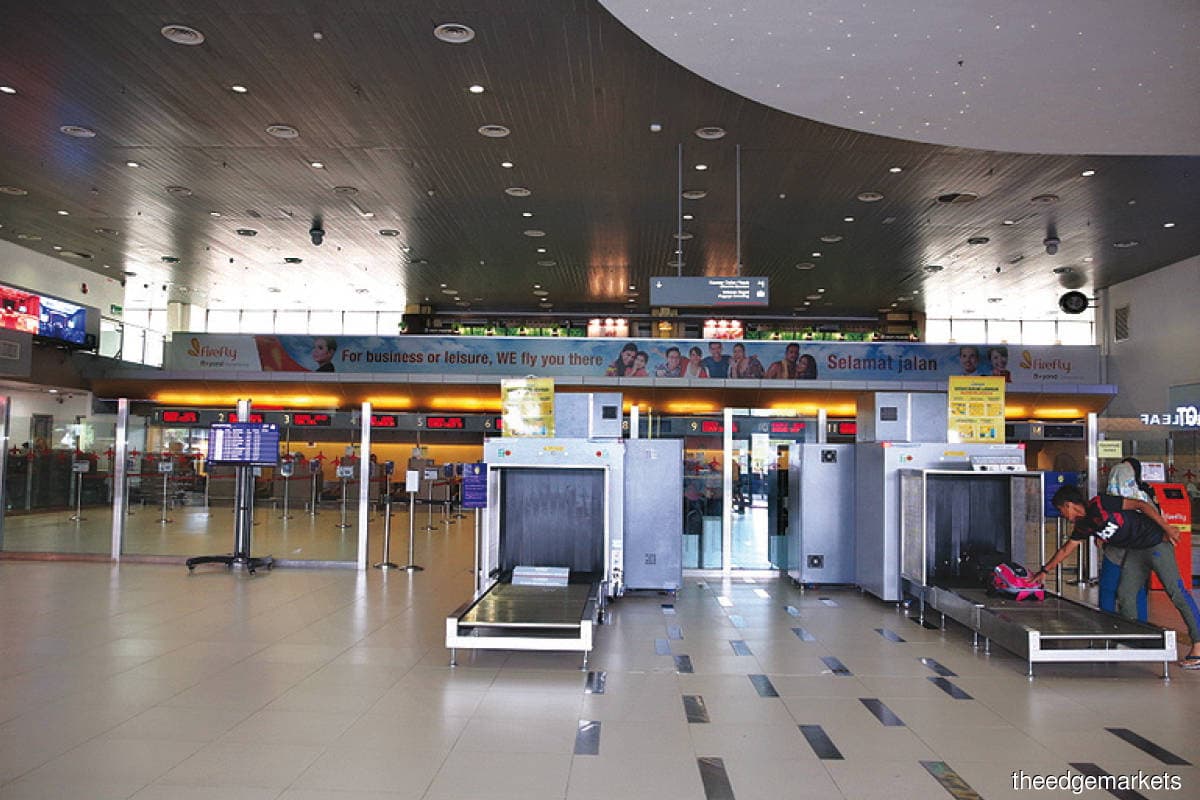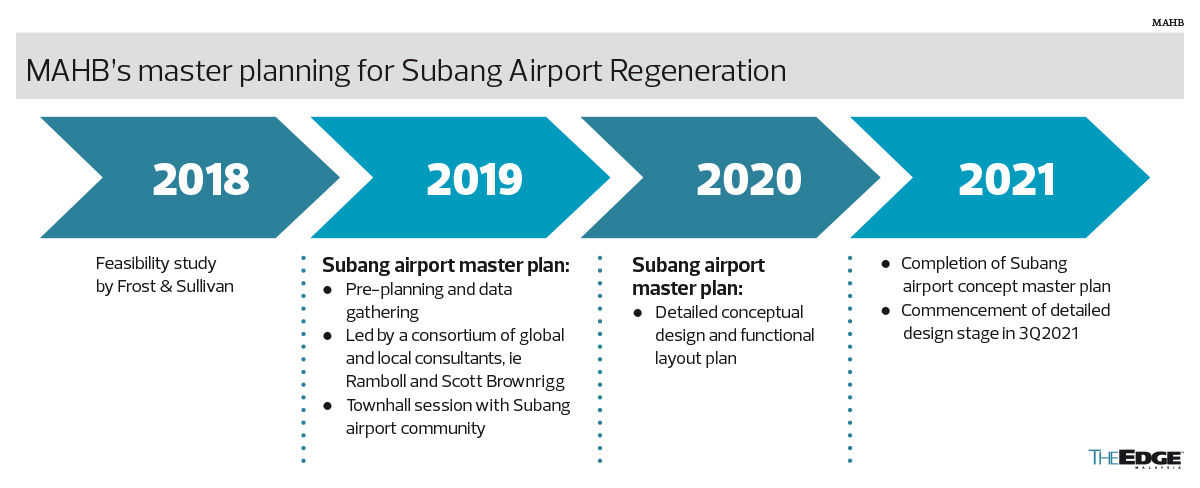
This article first appeared in The Edge Malaysia Weekly on June 14, 2021 - June 20, 2021
AVIATION players have called on the government to quickly agree to the proposed redevelopment of the Sultan Abdul Aziz Shah Airport in Subang, Selangor so that the project can make headway, or Malaysia will continue to lose out in the aviation game.
This comes amid a tussle between Malaysia Airports Holdings Bhd (MAHB), which is majority-owned by Khazanah Nasional Bhd, and construction and property firm WCT Holdings Bhd over the future of Subang airport and the direction they want to take it.
Last year, MAHB, the country’s largest airport operator, put forward a plan to the government to redevelop the airport, with the aerospace and maintenance, repair and overhaul (MRO) components central to the five-year plan, for approval. The RM1.3 billion Subang Airport Regeneration concept master plan was revealed by MAHB in a news briefing in April after three years in the works.
However, WCT has thrown a spanner in the works after it was found that it had submitted a separate proposal to the transport, finance and energy and natural resources ministries on March 1 to redevelop the airport at a cost of RM3.7 billion over 10 years. Ironically, WCT, through 60%-owned subsidiary Subang Skypark Sdn Bhd, currently operates the SkyPark Terminal (formerly Terminal 3) in Subang airport under a 30-year sublease concession agreement with MAHB that ends in December 2037, with the option to extend for 29 years.
MAHB group CEO Datuk Mohd Shukrie Mohd Salleh says the group is confident that it can continue to progress according to its set timeline, especially given its funding capabilities coupled with strong demand from current operators to expand, as well as new operators seeking to establish presence in Subang airport.
“Nevertheless, the full rollout of our redevelopment plans, especially on the brownfield sites, can only proceed after we have obtained the necessary approvals from the government,” he says in an emailed reply to questions from The Edge.
It is understood that the Transport Ministry is preparing a Cabinet paper on the matter.
Under its Subang Airport Regeneration plan, MAHB aims to commence redevelopment of current sites including demolition of the former Terminal 2 and other hangars in phases starting next year, which involves relocating some existing tenants.
“We have submitted this comprehensive plan to the government. As the plan is in line with the mandate to develop Subang airport to become the preferred hub for aerospace and business aviation in Asia-Pacific and is very much aligned with the Malaysian National Aerospace blueprint, as well as verified through extensive benchmarking and stakeholder engagements and validated by independent parties, we hope to get the government’s support in furthering our aims for the benefit of the nation,” says Mohd Shukrie.
All eyes are now on the government to see if it will allow Subang airport to be carved out from MAHB’s network of 39 airports in the country as it did in 2003 when it sold Senai International Airport in Johor to tycoon Tan Sri Syed Mokhtar Albukhary’s Senai Airport Terminal Services Sdn Bhd. However, in the case of WCT, it is looking to enter into a new 50-year concession with the government to operate the entire Subang airport area until 2092.
“Clearly, there is intense lobbying going on from both sides, which may delay the redevelopment of Subang airport. What’s on the table is that there is a potential for Subang airport to transform into a city airport,” a source familiar with the matter tells The Edge.
“There has been a lot of publicity recently from MAHB after the leak on what WCT intends to do. Honestly, MAHB’s plan for Subang Airport Regeneration is long overdue. This should have happened much faster and a long time ago,” he says, suggesting that MAHB be given a clear key performance indicator and a definitive timeframe for implementing the plan.
“A city airport has enormous potential and even if there is going to be some level of competition with Kuala Lumpur International Airport (KLIA), that’s healthy. The age of a monopolistic framework needs to be rethought as Malaysia comes of age.
“We cannot continue to remain a ‘jaguh kampung’ — a village champion. A city airport and KLIA will have [their] strengths to attract and build different aspects in the aviation value chain both regionally and locally. Singapore’s Seletar Airport is a good case in point. Thus, the revival of Subang airport needs to happen sooner rather than later; if not, Malaysia will continue to lose out in the aviation game,” the source adds.
However, as a government-linked company, MAHB faces a lot more structural constraints than a private developer in advancing new projects, according to a person familiar with the matter. “For one, it needs to ensure that its development plan for Subang airport is in line with the aviation ecosystem of other airports in the country. Its plans are also subject to layers of regulatory approvals.”
Mohd Shukrie says since being given the mandate by the government to develop Subang airport into an international aerospace park in March 2005 through a Cabinet decision, MAHB has grown it by four times and attracted global aerospace and aviation anchors into the ecosystem, which has spurred the breadth and depth of the local value chain.
A CEO of an airport management company, who declined to be named, says studies have shown that once a city receives 30 million to 35 million passengers, it makes sense to have additional airport capacity at a second location.
“Thus, Subang, with its proximity to the city centre, is ideally located. I am sure that a private promoter can develop Subang in a mixed-use environment into an airport city development like London City Airport. This would, however, require the loosening of the restrictions for commercial flights in Subang,” he says.
“Prior to the Covid-19 pandemic, FlyFirefly Sdn Bhd and Malindo Airways Sdn Bhd had a very efficient operation in Subang and an extension of that model to other point-to-point connections would make sense. With a cleverly set-up concession agreement, there could be substantial concession fees over time. Competition is always better than a monopoly. It is also for the benefit of taxpayers,” the CEO adds.
Since 1998, Subang airport has been limited to handling only propeller-driven aircraft such as turboprops, business jets, helicopters, and light and military aircraft to avoid cannibalising KLIA’s traffic and to make KLIA a strong aviation hub in the region.
“One can argue that KLIA will lose as a transit hub [if regional jet operations are allowed out of Subang airport]. However, as long as MAHB, Malaysia Airlines Bhd (MAB) and AirAsia Group Bhd are not really working towards this together, then I don’t think that is a strong argument for preventing Subang airport from developing,” the CEO says, noting that AirAsia, together with its low-cost long-haul affiliate AirAsia X Bhd, has set up its own hub at klia2.
“Subang airport could focus more on domestic flights. There are multiple cities worldwide with such [multiple airport system] setups such as John F Kennedy International Airport and LaGuardia Airport serving New York; Heathrow and Stansted, Luton and Gatwick airports in London; Narita and Haneda in Tokyo; Congonhas versus Guarulhos and Viracopos airports in Sao Paulo and Singapore’s Changi Airport and Seletar Airport. What’s important is that the overall traffic volume has to be substantial, but that was never a problem in KLIA,” he adds.
Return of commercial aircraft may squeeze out business jets, says aviation player
Critics of the proposal by WCT fear that allowing commercial passenger jets to return to Subang airport could potentially squeeze out private business jets, where Malaysia now finds itself in an enviable position, handling the most number of business jets in Southeast Asia.
Citing Jakarta’s old airport Halim Perdanakusuma International Airport, an aviation player says the airport was once the main airport for business aviation, but in 2014 the Indonesian authorities decided to open Halim airport to scheduled commercial airlines to reduce congestion at Soekarno-Hatta International Airport. “Initially, the authorities said they would only allow a small number of commercial flights given its ageing passenger terminal, but what ended up happening was that the private business jet operators had to free up their slots at Halim airport for commercial operations.”
The aviation player sees Subang airport potentially suffering the same fate as Halim airport, although he concedes that allowing regional jets to operate will make it more appealing for both passengers and airlines due to the airport’s close proximity to Kuala Lumpur, Shah Alam and Subang.
“But it has been many years since Subang ceased to be an international airport with scheduled commercial airline operations. It would have to be redeveloped, which could become an issue with the surrounding community. How do they feel about the extra traffic and noise coming from commercial jet operations? While the proposed plan [by WCT] states that Subang would be limited to handling regional jets, that decision feels like it could be the thin edge of the wedge. There is nothing to prevent them from reopening the airport to bigger aircraft later.
“Additionally, AirAsia and MAB currently do not have regional jets. So if Subang were to open up to regional jets, you are going to put them in a position where they either have to order regional jets to compete or allow a new competitor to come in, which might not necessarily be a Malaysian carrier. This would unnecessarily result in additional cost and adds complexity to their fleet. And it is probably something they don’t want to be doing in this current Covid-19 situation,” he notes.
Reopening Subang airport to regional jets could also potentially put existing turboprop operators like Firefly at a disadvantage.
“Take the Subang-Singapore route, for example. It is Firefly’s most lucrative route. Now the issue with turboprop operators is that they can only land at Singapore’s smaller secondary Seletar Airport. So if Subang airport were to open to regional jets, Firefly would not be able to compete as travellers would choose to fly out of Subang into Changi Airport,” says the aviation player.
Should Subang airport redevelopment be a private or public effort?
Critics say a private developer would put profit before everything else.
“If the airport was to be commercially-run, it would likely be profitable, and [a private developer] would have money to develop it faster,” says the aviation player.
“Still, not all airports should be run purely based on profit. You need to also take into consideration how it fits into the broader economic plan of the country,” he notes.
Save by subscribing to us for your print and/or digital copy.
P/S: The Edge is also available on Apple's App Store and Android's Google Play.

